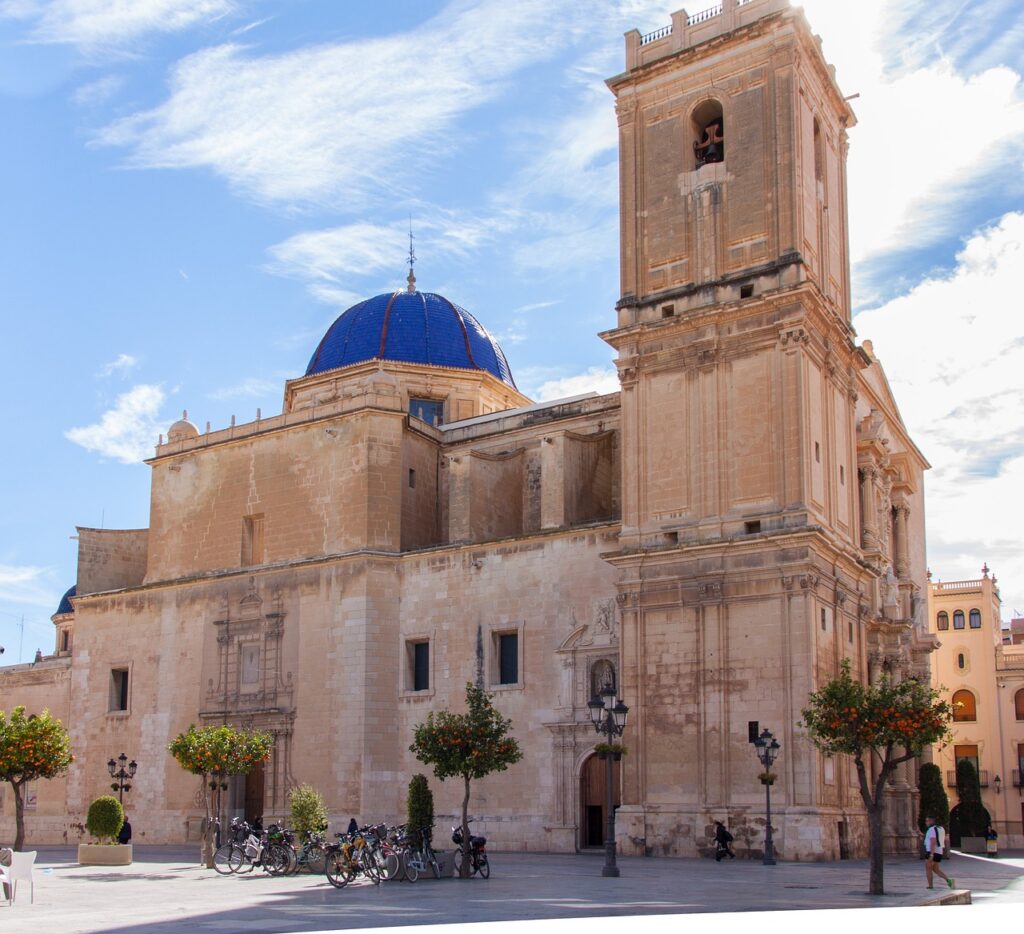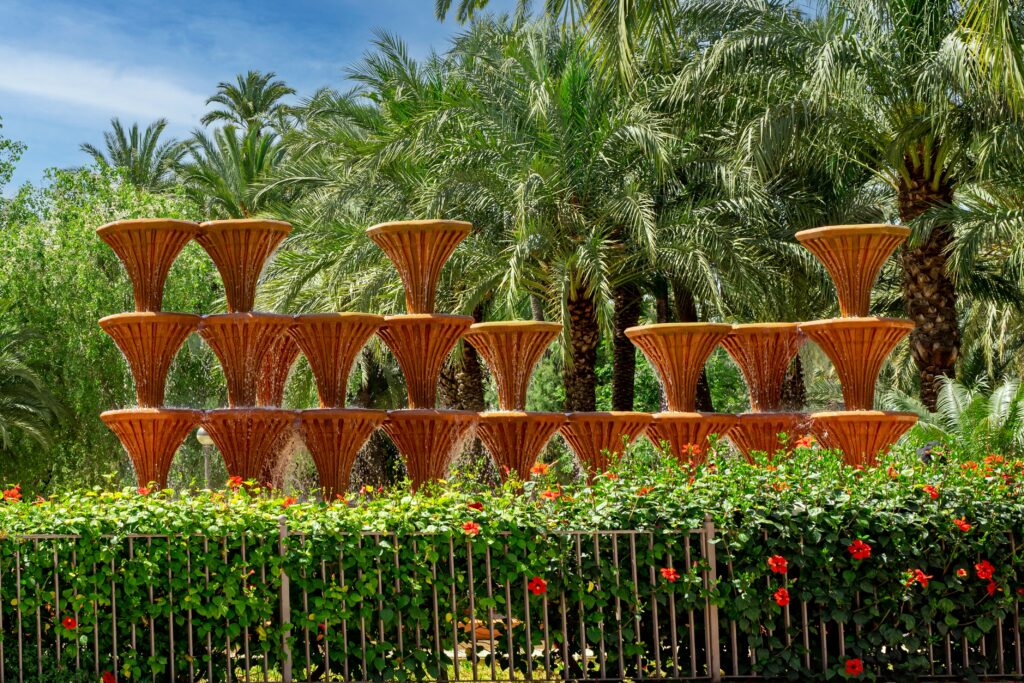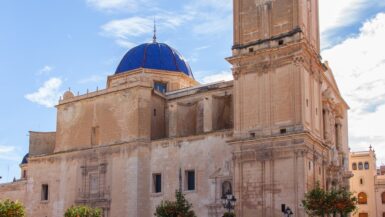Elche’s old town is full of fascinating historical sites, stunning architecture, and home to a palm grove so impressive it’s been named a UNESCO World Heritage site. There are so many things to do in Elche’s old town, which is worth making a day out of when visiting the town.

In this guide, I’ll take you through all the must-see spots in Elche old town – from the magnificent Basílica de Santa Maria and medieval Torre de la Calaforra to the stunning Palmeral and impressive Palau dels Altamira.
Taking a guided tour of the historical centre is a brilliant way to learn about Elche’s fascinating past. You’ll get to see the largest palm grove in Europe, learn about the famous Misteri d’Elx performance, and visit the Puçol Educational Project – all with expert knowledge to bring these sites to life!
You can book a guided tour through Get Your Guide below:
History of Elche
Elche has a rich history dating back over 2,000 years. It began as an Iberian settlement called Ilici, which later became a Roman colony. The Romans left their mark with urban planning that’s still visible in parts of the old town today.

But it was during the Muslim period (8th-13th centuries) that Elche gained one of its most distinctive features – the incredible palm grove. The Moors established an intricate irrigation system that allowed thousands of palm trees to thrive in this area.
After the Christian reconquest in the 13th century, Elche developed into an important agricultural and industrial centre. By the 19th century, it had become famous for its shoe-making industry, which remains important to the local economy.
Plaza de la Glorieta – the heart of Elche old town
The Plaza de la Glorieta is the central square of Elche old town and a perfect starting point for your visit. This lovely square is surrounded by palm trees (of course!) and features beautiful mosaic paving with designs inspired by local traditions.

It’s a brilliant spot to sit at one of the cafés, enjoy a coffee, and watch daily life unfold. The square connects to the main shopping streets and leads towards many of the important historical sites.
During festivals and holidays, Plaza de la Glorieta often hosts events and performances. If you’re lucky enough to visit during the Misteri d’Elx in August, you might catch some of the related celebrations here.
Basílica de Santa Maria
Just a short stroll from the Plaza de la Glorieta, you’ll find the magnificent Basílica de Santa Maria. This church was built between the 17th and 18th centuries in the baroque style, on the site of an earlier mosque.

The basilica has a stunning blue dome that stands out against the sky, and the main façade features intricate stonework that tells biblical stories. Inside, it’s just as impressive with a beautiful altar and several side chapels.
What makes this church extra special is that it’s the venue for the famous Misteri d’Elx, a medieval religious drama performed each August. This musical play depicts the death, assumption, and crowning of the Virgin Mary and has been recognised by UNESCO as a Masterpiece of Oral and Intangible Heritage of Humanity.
If you’re interested in seeing the interior, the church is usually open to visitors in the morning and late afternoon, with a small entrance fee. It’s well worth popping in.
Torre de la Calaforra
You can find the Torre de la Calaforra in the Plaza de Santa Isabel, behind the Basilica of Santa Maria. Its a fortress of Islamic origin one of the oldest buildings in Elche. This Almohad tower dates back to the 12th-13th centuries and was part of the medieval wall that once surrounded the city.
Standing at about 25 metres tall, it was designed as a defensive structure but later served various purposes including as a prison. Today, it houses a small museum dedicated to the history of Elche, with exhibits spanning from prehistoric times to the modern era.
The tower’s architecture shows clear Islamic influences, with its characteristic square shape and thick walls. What I love about visiting is climbing to the top for brilliant views across the old town and palm grove – you get a real sense of how these two elements of Elche fit together.
Palm Grove of Elche (Palmeral de Elche)
While not entirely within the old town, the Palm Grove of Elche deserves special mention as it’s so intimately connected with the city’s history and identity. This remarkable collection of over 200,000 palm trees is the largest in Europe and was declared a UNESCO World Heritage Site in 2000.
The palm grove dates back to the Moorish period, when an ingenious irrigation system was created to make agriculture possible in this dry region. Many of the historical huertos (garden orchards) are open to the public, with the Huerto del Cura being the most famous.
What I find most impressive about the palm grove is how it intertwines with the urban area – you’ll spot clusters of palms throughout the old town, creating a unique atmosphere that feels almost like an oasis.
If you’re visiting in summer, try to schedule your walk through the palm gardens for early morning or evening, as the midday heat can be quite intense. The dappled shade of the palm trees provides welcome relief from the sun.
Palau dels Altamira (MAHE Museum)
The Palau dels Altamira is a former palace that now houses the Museu Arqueològic i d’Història d’Elx (MAHE). This impressive building combines elements from different periods – its foundations date back to Islamic times, while the main structure was built in the 15th century as a fortress-palace.
Inside, the museum offers an excellent overview of Elche’s history, from prehistoric times through to the modern era. The star attraction is undoubtedly the Lady of Elche, although the original bust is in Madrid’s National Archaeological Museum, a perfect replica is displayed here in Elche.
I particularly enjoy the sections dedicated to the Iberian and Roman periods, which include some fantastic artefacts found in local excavations. The building itself is also fascinating, with its blend of gothic and renaissance elements.
The museum has good English information throughout, making it accessible for international visitors. There’s a small entrance fee, but it’s free on Sundays – worth keeping in mind if you’re on a budget.
Museu Arqueològic i d’Història d’Elx (MAHE)
While the MAHE is housed in the Palau dels Altamira as mentioned above, it deserves its own section due to the importance of its collections. This museum tells the complete story of Elche from prehistoric times to the present day.
The museum is organised chronologically, taking you through the various civilisations that have called this area home. The exhibition spaces are modern and well-designed, with plenty of interactive elements that make the history come alive.
Some of the most notable artefacts include Iberian ceramics, Roman mosaics, and Moorish pottery. The museum also has a section dedicated to the agricultural traditions of the area, with a focus on the palm cultivation that has shaped Elche’s landscape.
What I appreciate most about this museum is how it connects the archaeological findings to the visible remains throughout the city – after a visit here, you’ll look at the old town with new eyes, able to spot the layers of history in its streets and buildings.
Practical information for visiting Elche old town
- Getting there: Elche is easily accessible from Alicante, with regular trains and buses making the 20-minute journey. If you’re coming from Benidorm, it’s about an hour by car or you can take a train via Alicante.
- Best time to visit: Spring and autumn offer pleasant temperatures for walking around. If you visit in August, you might catch the Misteri d’Elx performances, but be prepared for hot weather.
- Walking shoes: The old town has some cobbled streets, so comfortable walking shoes are a must.
- Language: While many people in the tourism industry speak English, Elche is less internationally touristy than the coastal resorts, so having a few basic Spanish phrases is helpful.
- Time needed: You can see the main highlights of the old town in half a day, but I’d recommend a full day to really appreciate it without rushing.
Elche old town offers a wonderful glimpse into the authentic Spain that many visitors to the Costa Blanca miss out on. With its unique blend of historical sites, stunning palm groves, and genuine local atmosphere, it makes for a refreshing change from the beach resorts and a chance to connect with the region’s rich heritage.



